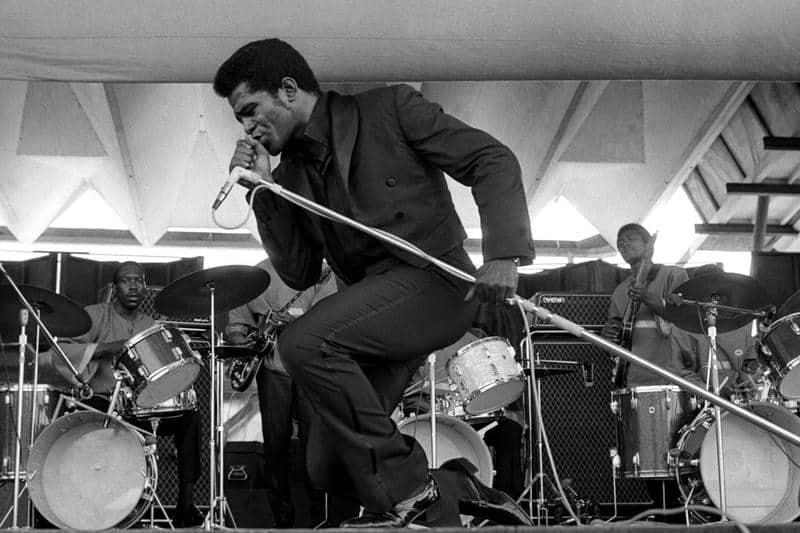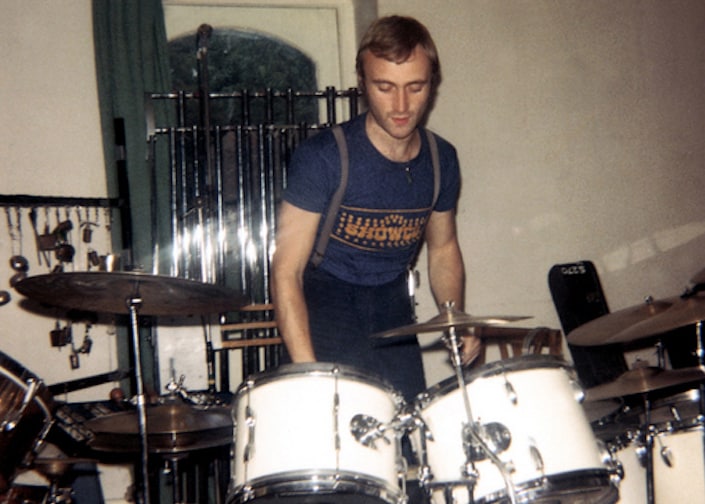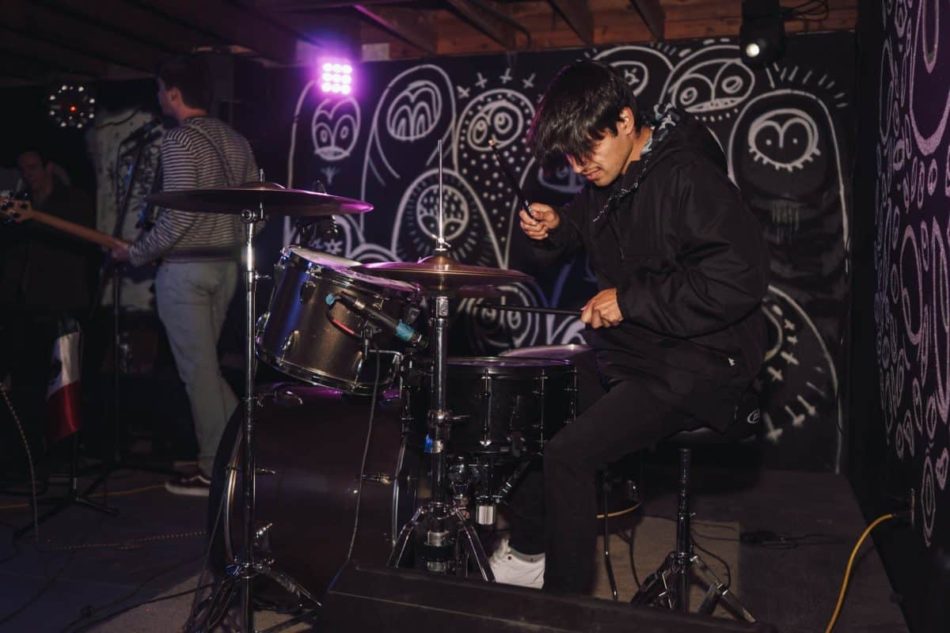Having two drummers in a band can sometimes seem just a bit excessive. Even though it may look strange at first, there’s typically a legitimate reason (or two) behind a band adding a second or even third drummer.
Why do bands have two drummers? Bands have two drummers to create a thicker, fuller, or denser sound. Having two drummers can introduce more variation and intensity into a performance.
Groups like Genesis, The Allman Brothers Band, and James Brown successfully toured with two or more drummers for years, and it’s something many bands still imitate to this day.
But there are also situations where having two drummers doesn’t exactly mean two drum kits. Some bands have several drummers on stage at a time playing percussion instruments like bongos, floor toms or standing bass drums. Every situation is different and this guide will walk you through the most common ones.
Just Incase Someone Quits – James Brown

Photo: Tom Copi
Before James Brown, having one drummer was enough.
Although he wasn’t the first, many musicians credit Brown as the “father” of double drummers, inspiring countless others to adopt the addition of a second and sometimes even a third drummer. But what has historically been seen as innovation and creative risk-taking, happened almost by accident.
Legend says sometime in the early 1960s Brown’s band refused to perform, claiming the singer had become increasingly difficult to work with. After eventually succumbing to the band’s demands, Brown swore, “I’ll never be caught without two of everything.”
The singer quickly hired multiple musicians for each instrument, adding several drummers, guitarists, bassists, and an entire horn section. At any given time, Brown had 40 to 50 musicians to choose from, just in case of another mutinous uprising.
Eventually, two of Brown’s drummers (John “Jabo” Starks and Clyde Stubblefield) congealed so well that Brown couldn’t split them up. Their styles were polarizing, but together they laid the foundation of double drummers in modern music.
The Allman Brothers Band, the Grateful Dead, Radiohead, Joe Walsh, and countless others have credited Brown, Starks, and Stubblefield for inspiring them to bring two drummers to the table.
The More The Merrier – The Allman Brothers Band

Photo: Kirk West
In modern recording and music production, layering instruments like the drums isn’t a foreign concept. Adding multiple tracks to increase the audio quality of a song and create a thicker sound is common practice. The Allman Brothers wanted that same fullness to carry over into their ‘live’ performances.
According to the band’s legendary percussionist Jaimoe, Duane Allman knew he wanted two drummers the moment he started The Allman Brothers Band.
“I asked Duane why he wanted two drummers and he said, ‘Because James Brown has two,’” said Jaimoe.
These two drummers, Jaimoe and Butch Trucks, quickly developed a unique musical relationship on and off stage. The two flawlessly combined styles to become one massive drumming machine.
Individually, they played extremely differently, but together they were perfectly out of sync. Trucks traditionally drove the band like a pulse, keeping time while Jaimoe embellished on Trucks foundation. Adding explosive fills and Jazz-like flourishes Jaimoe and Trucks made The Allman Brothers Band one of the most iconic groups to ever pull-off having two drummers.
In fact, in 1991, The Allman Brother’s Band added a third drummer, percussionist Marc Quinones. According to Wikipedia, “The general pattern was that Trucks was the timekeeper, Johanson added colors, and Quiñones established rhythms that the guitarists played against.”
With an army of drummers (sometimes even four), The Allman Brothers Band established themselves as masters of percussion in a way that no one in rock music has successfully duplicated since.
A Drummer That Sings – Genesis

Photo: Richard MacPhail, from the book ‘Genesis: Chapter & Verse’
Introducing double drummers to pop music, Genesis is arguably the most mainstream band to have successfully had two drummers.
Phil Collins found himself filling-in as lead vocalist after the departure of the band’s beloved, theatrical frontman Peter Gabriel in 1975. In fact, the band’s first album after Gabriel, A Trick of the Tail, Wind & Wuthering was written without vocals. It was only after auditioning several vocalists that Collins stepped up to the plate.
Naturally, Collins continued to write and record as the band’s drummer on future Genesis albums but instead of trying to balance both acts on tour, Collins recruited Weather Report’s Chester Thompson to fill the role of the band’s ‘live’ drummer.
Thompson certainly added more dynamic to the band’s ‘live’ performances. Together, they regularly improvised duets they called “Drums, Drums & More Drums.” Even after pursuing a lengthy solo career, Collins almost always toured with two drummers and regularly accompanied his band behind the kit.
Listen to how much additional-depth Thompson adds to Collins’ performance of “In The Air Tonight”.
Nothing But Drums – Imagine Dragons
Of course, having two or more drummers in a band doesn’t always mean multiple drum kits on stage. Introducing multiple percussionists increases the number of instruments that can be played simultaneously.
This is frequently done in Latin and reggae music but also rears its head in jam bands like the Grateful Dead, gospel and hip hop groups like Kanye’s Sunday Service, and performances from genre-bending artists like Bon Iver.
It’s also theatrical. Like the Imagine Dragons performance above, violently beating large, booming drums is exciting to watch. It’s a rallying war-cry to the audience in attendance.
I remember watching an early performance of Sleeping With Sirens where Kellin Quinn, the band’s frontman, brought out a floor tom and poured water over the drum’s head. The water, reflecting in the stage lights and smoke, added an explosive visual element to the additional percussive sound.
Certainly more subtle, adding smaller percussive instruments, like the tambourine or cowbell (“I need more cowbell!”), can help a band keep time while the individual members add flashy solos or fascinating accents.
Like a second drummer, a percussionist can significantly add to the overall groove of a performance.
Continuing To Carry The Torch – Atomic City

Photo: Jordan Henrie / Ennui Magazine
Despite countless examples of double drummers in rock and roll, it wasn’t until I saw this psychedelic, jazz-rock trio in Rexburg, ID, that I realized how beneficial having two drummers could be.
Sure, I’d seen YouTube videos of drummers dueling over EDM tracks, and everyone’s seen Will Ferrell and Chad Smith’s hilarious drum-off on The Tonight Show. But before Atomic City hired me to document a ‘live’ recording session, having two drummers just seemed like a gimmick.
In high school, a friend of mine joined a band that somehow ended up with two drummers. They played every show with two drum kits, facing each other in the center of the stage, sharing a single kick drum. Maybe it was because it was my first exposure to double drummers, but it just seemed like nobody was brave enough to tell Dylan he was out of the band (sorry, Dylan!)
So when I showed up to the Atomic City session with no real idea what I was getting into, the first thing I said was, “Wait, two drummers?!”
But sitting there, taking pictures between takes, I realized what a dance having two drummers could be — ebbing-and-flowing like waves in the ocean, around the sandy melody of a single guitar.
Instantly, I was hooked.
I started looking into the history of double drummers. I learned about James Brown and The Allman Brothers Band. I realized I’d watched ‘live’ recordings of Genesis, with Collins on the drums.
The deeper I looked, the more examples I realized had been directly in front of me. Emo-icons like Brand New regularly added a second drummer to their ‘live’ shows. The Used and My Chemical Romance recorded a cover of David Bowie and Freddy Mercury’s “Under Pressure” with two drummers. Radiohead recently ventured into the world of two drummers. Even John Mayer tours with two drummers.
Something I previously thought stemmed from indecisiveness turned out to have much deeper roots. The memory of legends like Jaimoe and John “Jabo” Starks continues to influence generations of drummers who’ve long forgotten their names.
Related Questions
When did drum kits become popular? The standard drum kit became popular during the Jazz era (1910 – 1930). Before then, drum kits were smaller, including only a single drum or two and most percussion parts were played by separate musicians, like in marching bands. The drum kit we know and think of today was an evolutionary process — percussionists slowly added more drums and cymbals over time.
Why do drummers play on rugs? Drummers play on rugs because it keeps the drum kit from slipping away while they’re playing. Most stages are made of wood or metal and can be very slippery. A rug or small carpet can help a drummer keep their kit stable, so they’re not constantly adjusting pieces during a performance. A rug also makes it easy to move the entire kit — for opening bands, being able to get off stage quickly is an important part of live performances.
Why do some bands have three guitarists? Like having multiple drummers, bands will add a second or third guitarist to add depth and density to their sound. Usually, a rhythm guitarist will play chords to lay the foundation and a lead guitarist will play riffs or solos that add excitement to the song. A third guitarist could mean the singer is strumming an acoustic guitar to add a softer dynamic to a song. Most commonly tough, bands will only have one or two guitarists and a bass player, which to the untrained eye looks a lot like a guitar.
For more industry tips and music marketing hacks, check out Ennui Magazine. You can also follow us on Facebook, Twitter, Instagram, Pinterest, and YouTube.
